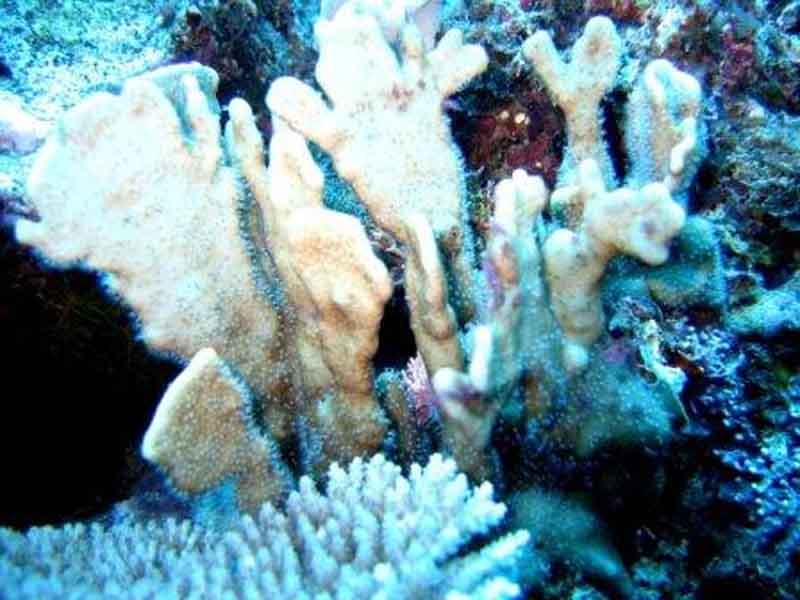By EMOSI LASAQA
The Blue Coral, scientifically known as Heliopora Coerulea that was found on one of the reefs off Tiliva Island, Viwa in Yasawa was first discovered by former Mamanuca Environment Society scientist Dine Walker way back in 2004 at Tokoriki Island in the Mamanuca groups.
A Press Release from the University of the South Pacific on 15 May stated that the blue coral was discovered during a trip by a team from the university (USP) and the Ministry of iTaukei Affairs
It went on to say that Mr Ron Vave, who works as a Senior Scientific Officer at the Institute of Applied Science based at USP, was part of the Ministry of iTaukei Affairs team. He said that in his 12 years of diving experience in Fiji, he had not seen the blue coral in Fiji waters until his trip to Viwa Island.
But Tokoriki Island Resort based Dive Tropex owner and PADI Dive Instructor Alex Ragg who said the discovery was made eight years ago while conducting a reef check.
“She (Ms Walker) broke off a piece to be absolutely sure and sent it to Ed Lovell a well known coral expert, who verified the discovery. The site, which we have called ‘Blue Coral Reef’, is around two nautical miles west of Tokoriki. There are quite a lot of blue coral there, a lot more than sighted off Viwa.
“We can recall offhand three patches in 10 -14meters, 1 x 5 metres square, 1 x 6 metres square and 1 x 1 metres square”
Mrs Ragg said there was also a sub pinnacle in around 18meters (which they didn’t fully explore) which looked to be covered in blue coral.
And they are delighted to take part in any survey concentrating on the blue coral.
In a statement soon after the discovery, Ms Walker-who was the first Project Manager for Mamanuca Environment Society stated that having dived the Mamanuca Islands extensively and never having observed the coral, she was very much of the same opinion of most experts that Blue Coral just did not exist in Fiji.
She said the Low Isles on the northern Great Barrier Reef probably represent the southern-most reported presence of Heliopora and American Samoa the eastern-most, with a line being drawn at the Island of Rotuma for distribution of the coral into Fiji.
Walker further stated that experts have declared this coral extinct in Fiji with no recent observations having been made of the coral being alive.
“Reports made in 1985 consider the presence of the coral in Fiji doubtful as it was not recorded in beach sediments or coral assemblages studied in and around the Fiji Islands. The study also declared that the genus was formerly present in Fiji since Heliopora fijiensis was named by Hoffmeister (1945) from Miocene deposits on the Fiji Island chain of Lau.”
Walker said patch reef where the Heliopora coerulea was observed growing on in Tokoriki was very intact.
She noted that a large massive porites colony measuring 5meter by 5meter was observed close to the growth site as were numerous unusually large Giant clams (Tridacna Squamosa) with the shell measuring over 70cm in length.
“Although this site is surrounded by a resort and could be frequently used by the two neighbouring island villages for fishing and collection of invertebrates, it appears to be relatively untouched. The colonies of Blue Coral were small with maximum height of 20centimeter and width of about 40centimeter.
There were many colonies observed but only on a small section of the reef. This does raise the question of whether these colonies are ancient relics, due to the obvious intact state of the reef or new invaders to the group due to their small colony size.
“This Coral, also commonly known as Blue Ridge Coral, is used in other islands where it is commonly found for jewellery and also in the aquarium trade due to its unusual Sky Blue skeleton.
“The Skeleton is made of aragonite deposits and the Coral closely related to the Octocoral family which means the polyps have eight tentacles. It produces a hard skeleton unlike most other ‘octocorals’ and it is a tawny brown colour on the outside,” Ms Walker said.


